Hokusai – The Road to Mt. Fuji

This year is the 170th anniversary since the death of Katsushika Hokusai (1760~1849) on April 18th, 1849. In commemoration, Ota Memorial Museum of Art will host “Hokusai – The Road to Mt. Fuji” to exhibit how Hokusai continued painting Mt. Fuji as his life-long project.

Katsushika Hokusai “View of Sensō-ji Temple”(2nd term)
An early work by Hokusai in his late 20’s.

Katsushika Hokusai “Hodogaya”(2nd term)
A series of works of the Tokaido road by Hokusai in his late 40’s.
His long artistic career before the birth of “Thirty-six Views of Mt. Fuji”
Hokusai continued printing landscape pictures over the 70 years of his career as an artist. We will present Hokusai’s long artistic journey which lead to the production of his representative works, “Thirty-six Views of Mt. Fuji” at the age of over 70. We will then explore Hokusai’s further ambitions after “Thirty-six Views of Mt. Fuji”, which he pursued until his death at the age of 90.
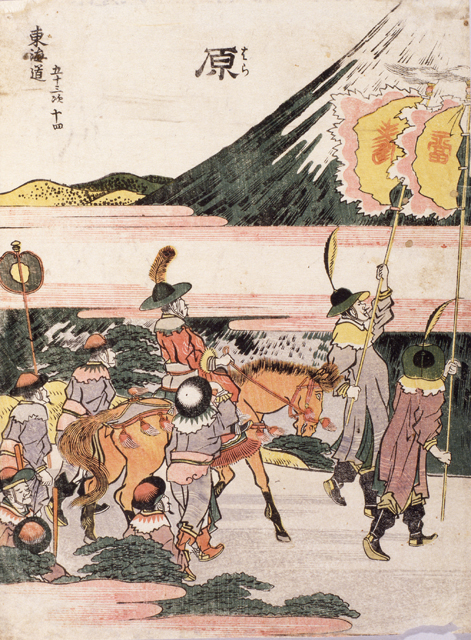
Katsushika Hokusai “Fifty-three Stations of the Tōkaidō Road : No. 14, Hara”(1st term)
A series of works of the Tokaido road by Hokusai when he was around 50. The Korean delegation looking at Mt. Fuji.
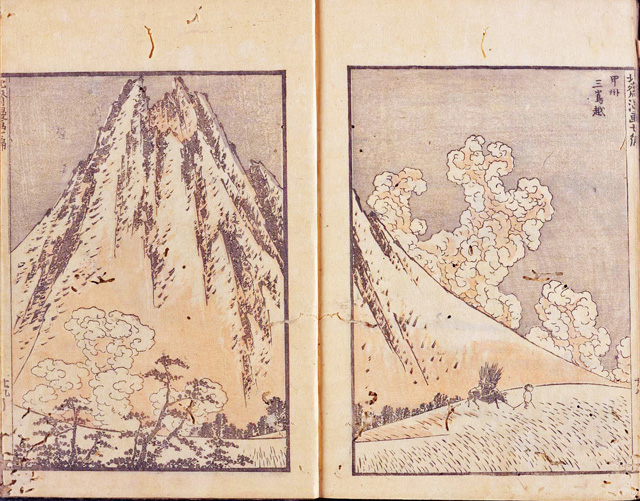
Katsushika Hokusai “Hokusai Manga” Volume 7(1st term)
Mt. Fuji by Hokusai when he was 58.
100 unique Mt. Fuji by Hokusai
This exhibition presents the development of Hokusai’s landscape pictures by chronologically introducing his works. Among the over 200 works exhibited are paintings of 100 different interpretations of Mt. Fuji through the eyes of the mastery of Hokusai.
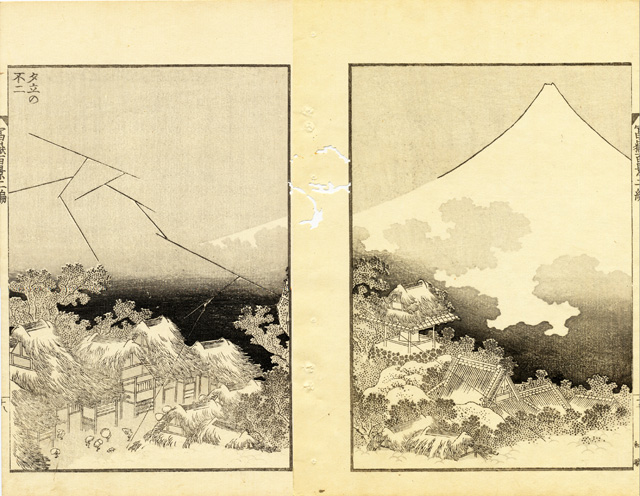
Katsushika Hokusai “One Hundred Views of Mt. Fuji” Volume 2 : Mt. Fuji in the Sudden Shower(2nd term)
A work by Hokusai when he was 76.

Katsushika “HokusaiOne Hundred Poems Explained by the Nurse : Yamabe no Akahito”(1st term)
A work by Hokusai when he was 76.
24 works from “Thirty-six Views of Mt. Fuji” will be printed in the Japanese passport
24 works from “Thirty-six Views of Mt. Fuji” will be printed in the Japanese passport
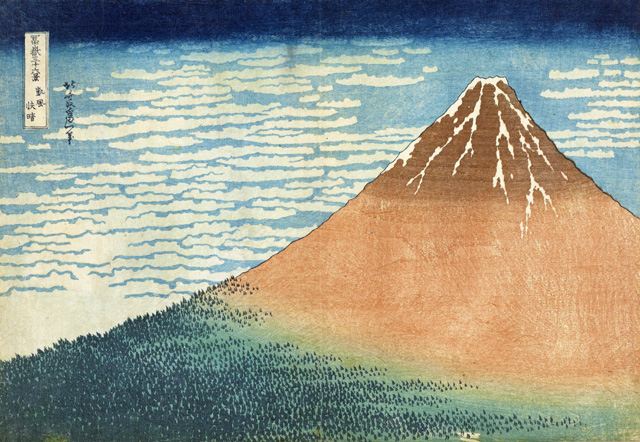
Katsushika Hokusai “Thirty-six Views of Mt. Fuji : Mild Breeze on a Fine Day”(2nd term)
A work by Hokusai when he was 72.

Katsushika Hokusai “Thirty-six Views of Mt. Fuji : Mild Breeze on a Fine Day”(1st term)
A work by Hokusai when he was 72.
Highlight of the exhibition
Katsushika Hokusai “Thirty-six Views of Mt. Fuji : Great Wave off the Coast of Kanagawa”(1st term)

“Thirty-six Views of Mt. Fuji” is the series of pictures of Mt. Fuji depicted from various places in Japan. It was published around 1831, when Hokusai was 72. Because of its extreme popularity, 10 pictures were added to the original 36 works. Among these 46 pictures, “Great Wave off the Coast of Kanagawa” is the most well-known. Hokusai beautifully captures the moment the big wave rises as high as a mountain just before collapsing. This powerful depiction of the wave could not have been achieved without Hokusai’s untiring observation of the movement of waves, represented throughout the works in this exhibition.
Admission
| Adult | 1000 yen |
|---|---|
| University and High school students | 700 yen |
| Junior High School Students and below | Free |
Calendar
Closed
-
-
-
-
2019 April
SUN MON TUE WED THU FRI SAT 1 2 3 4 5 6 7 8 9 10 11 12 13 14 15 16 17 18 19 20 21 22 23 24 25 26 27 28 29 30 -
2019 May
SUN MON TUE WED THU FRI SAT 1 2 3 4 5 6 7 8 9 10 11 12 13 14 15 16 17 18 19 20 21 22 23 24 25 26 27 28 29 30 31
-
-
-
Ohara Koson
[2nd Term] March 1st-24th
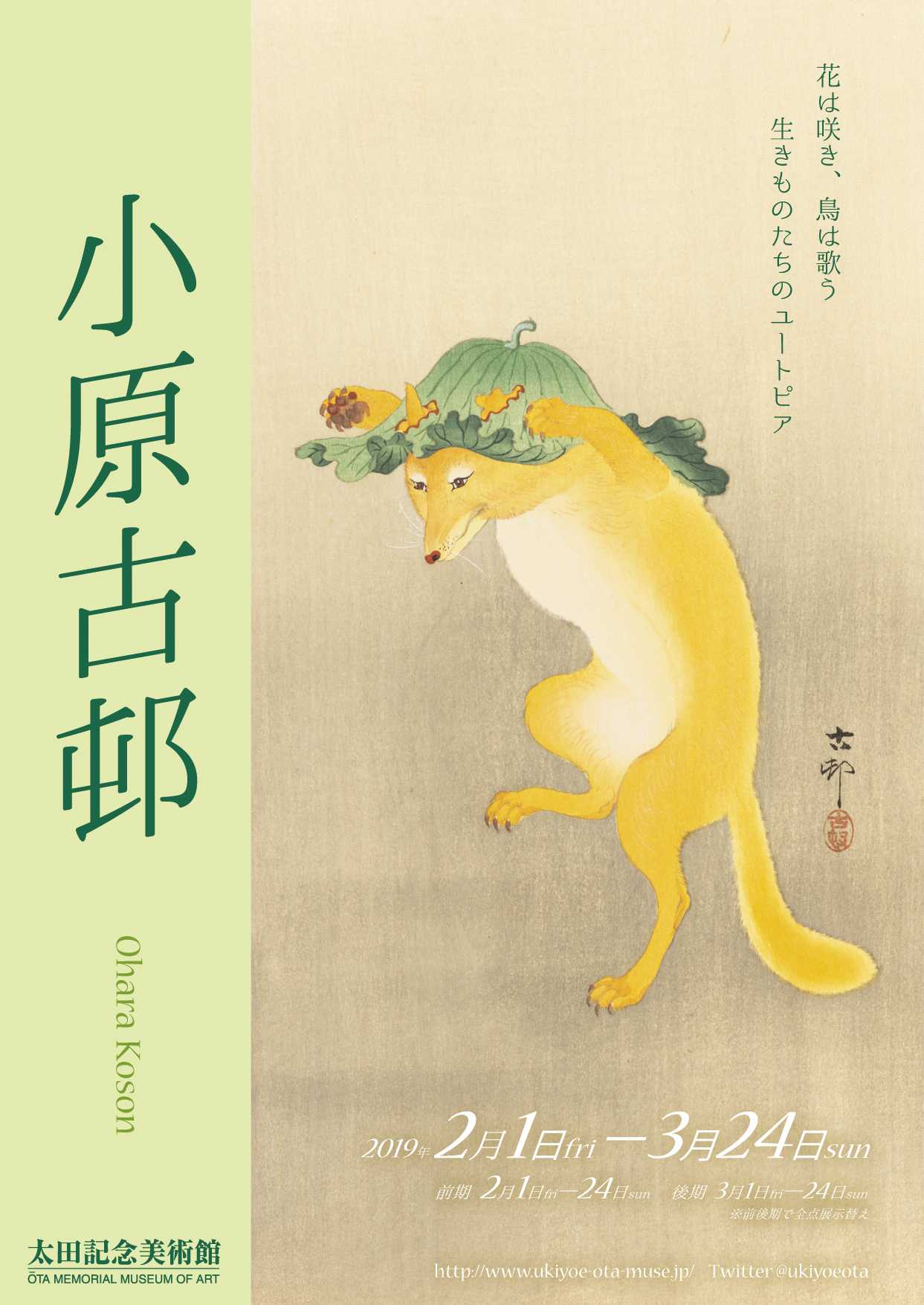
The hottest artist, Ohara Koson.
Ohara Koson (1877-1945) was a kacho-ga artist active from the end of the Meiji period and through the Taisho and Showa periods. Although there are many collectors of Koson and exhibitions are held abroad, he is hardly known in Japan. However, in September 2018, an exhibition “Ohara Koson – An Eden of Flowers and Birds” was held at Chigasaki City Museum of Art. Moreover, an E-Television program showcasing Koson and the exhibition was broadcast, and suddenly he has been drawing attention. In addition, a string of books about his art will be published, and in the current booming Japanese-style art world, without doubt, he is an artist on the edge of breaking through, and set to rise in popularity in his native Japan.

Dancing Fox [1st Term]

Domestic Geese [1st Term]

Horned Owl and Moon [2nd Term]
Are they really woodblock prints? Yes, charmingly portrayed animals as delicate as watercolors…
The major characteristic of Koson’s works is how he so elegantly expressed natural motifs such as birds, animals and flowers using woodblock print techniques. Actually, at first glance his works do not look like woodblock prints. However, based on the ukiyo-e print skills honed since the Edo period, he succeeded to express pale and beautiful colors as if they were watercolor paintings. His works can be loved not only by animal lovers, but also by everyone who appreciates art.

Monkey and Bee [1st Term]
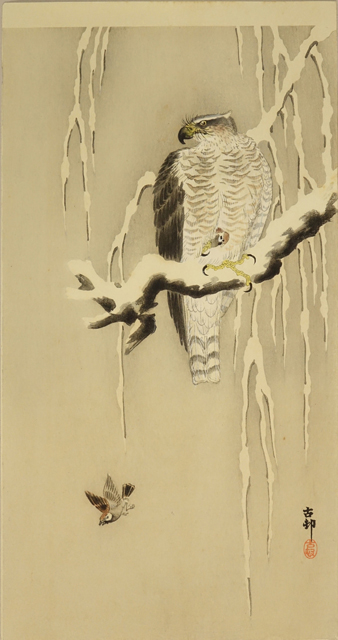
Goshawk and Sparrow [2nd Term]
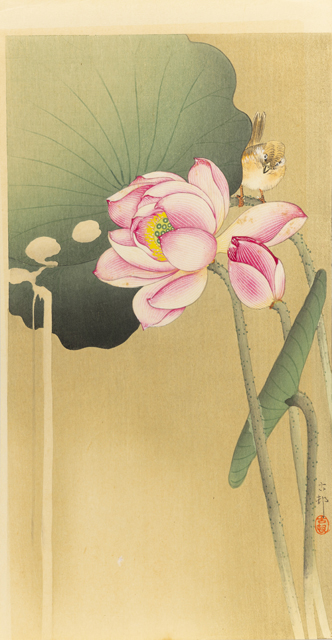
Sparrow on Flowering Lotus [1st Term]
The first exhibition introducing the complete world of Koson in Tokyo
This is the first exhibition to introduce the complete world of Ohara Koson in Tokyo. We will exhibit about 150 pieces, including works with the seal of Koson published by Matsuki Heikichi from the end of the Meiji period to the Taishō period, and shin-hanga works with the seal of Shōson published by Watanabe Sōzaburō in the early Shōwa period. In addition, hand-painted base pictures and test prints allowing a deeper understanding of Koson’s production process will be introduced. The exhibits will be changed between the first term and the second term.
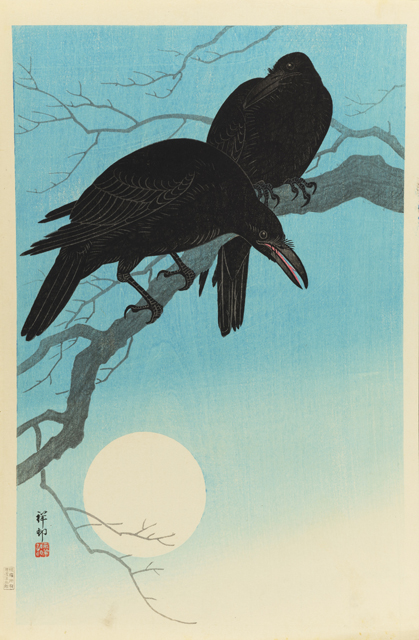
Crows in Moonlit Night [2nd Term]
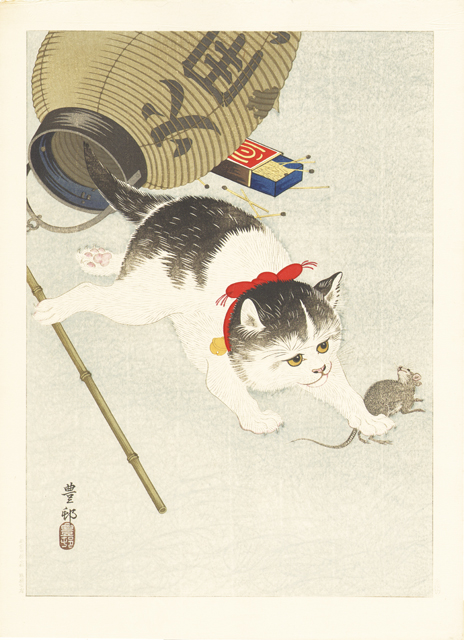
Cat and Paper Lantern [2nd Term]
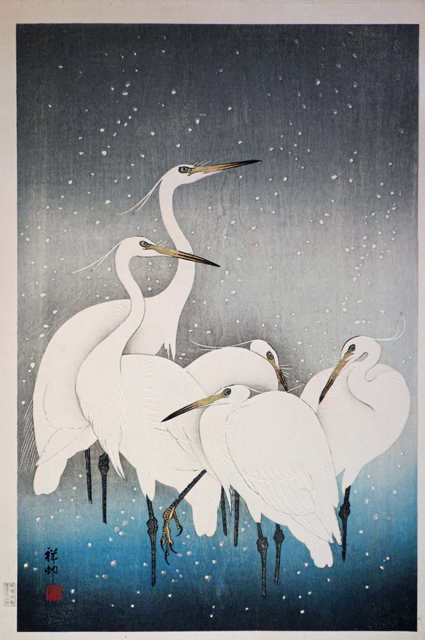
Egrets in Snow [2nd Term]
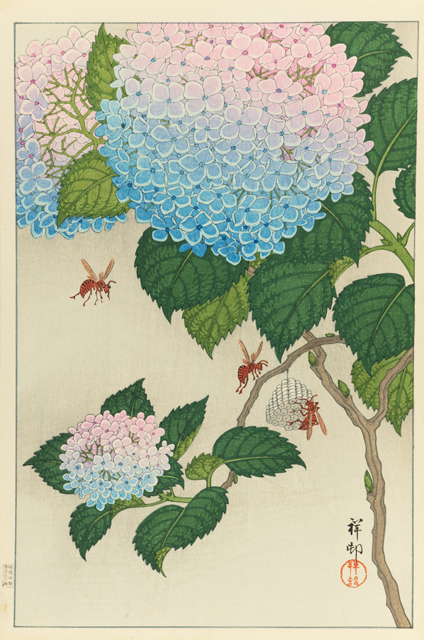
Bees and Hydrangea [1st Term]
Admission
| Adult | 700 yen |
|---|---|
| University and High school students | 500 yen |
| Junior High School Students and below | Free |
Calendar
Closed
-
-
-
2019 February
SUN MON TUE WED THU FRI SAT 1 2 3 4 5 6 7 8 9 10 11 12 13 14 15 16 17 18 19 20 21 22 23 24 25 26 27 28 -
2019 March
SUN MON TUE WED THU FRI SAT 1 2 3 4 5 6 7 8 9 10 11 12 13 14 15 16 17 18 19 20 21 22 23 24 25 26 27 28 29 30 31
-
-
Cute and Funny Ukiyo-e


Utagawa Hiroshige “One Hundred Famous Views of Edo : Asakusa Ricefields and Torinomachi Festival”
Cute and funny creatures
Cute animals such as cats, dogs, rabbits and birds, witty racoon dogs, foxes, and peculiar fictional creatures are popular figures in ukiyo-e. Personifying any creature or object, from octopuses and frogs to ground cherries is a specialty of ukiyo-e artists.
Ijū “Arrowhead with Heron”
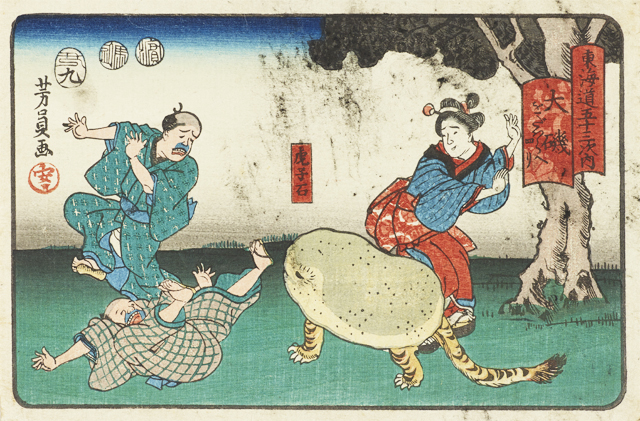
Utagawa Yoshikazu “Fifty-three Stations of the Tōkaidō Road : Ōiso”

Utagawa Yoshifuji “Monster Cutting Woman’s Hair”

Utagawa Kuniyoshi “Chinese Lanterns : Jumping from the Boat to Boat”
Cute children

Suzuki Harunobu “Five Shades of Ink : Poem by Somaru /Mischievous Girls”
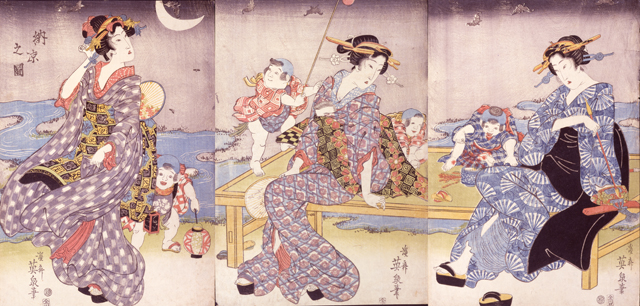
Keisai Eisen “Enjoying Cool Evening Breeze”
Funny people
A genre of ukiyo-e called “giga (farcical pictures)” which depicts comical subjects was very popular during the Edo period. Slapstick comedies by humorous people and parodies of well-known classic stories were often illustrated by ukiyo-e artist. These ridiculous scenes are equally amusing for present-day viewers.
Utagawa Hiroshige “Fifty-three Pairings for the Tōkaidō Road : Futagawa”

Utagawa Hirokage “Comical Views of Famous Places in Edo : No. 7, Strong Wind on Atarashi-bashi Bridge”
Cute or eccentric? – Design in Edo.
In ukiyo-e, we can often find cute motifs such as animals on kimono patterns. However, these motifs are sometimes surprisingly strange. In this section, let us look at cute and funny designs of kimono in ukiyo-e.
Utagawa Kunisada (Toyokuni Ⅲ) “One Hundred Beautiful Women at the Famous Places in Edo : Higashi-Honganji Temple”

Utagawa Kunisada “Collection of Beautiful Women : Concubine”
Highlight of the exhibition
Artist Unknown “News of Lightning / Hōnen-uo (The fish of harvest)”

Don’t you think that the monster at the bottom reminds us one of the most famous monsters in a Japanese film? However, it gives off a weird sense of being poorly-made, and it is comical and funny than scary. In fact, this monster is a big fish that is said to have appeared in the Yodo River during the late Edo Period. According to the text in the picture, it had black moss on its back and its eyes were like mirrors. With a body like that of a weasel and legs like those of a turtle, it weighed 75 kilograms and had a length of 2.3 meters. Because the previous time this monster had appeared, there were years of bountiful harvest, people believed in its luck, and named him “Honen-Uo” (The fish of harvest). Despite its peculiar looks, it was in fact a monster of good luck.
Admission
| Adult | 700 yen |
|---|---|
| University and High school students | 500 yen |
| Junior High School Students and below | Free |
Calendar
-
-
-
2019 January
SUN MON TUE WED THU FRI SAT 1 2 3 4 5 6 7 8 9 10 11 12 13 14 15 16 17 18 19 20 21 22 23 24 25 26 27 28 29 30 31
-
-
Fashion in the Yoshiwara Pleasure Quarter
[2nd Term] November 30th-December 20th

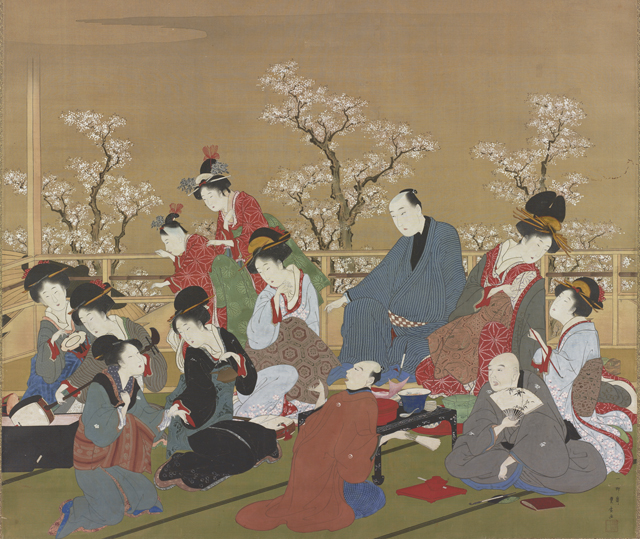
Utagawa Toyohiro “Cherry Blossoms Viewing Party”(2nd term)
The Yoshiwara flourished as a prominent pleasure quarter. The highest-ranking courtesans, called Oiran, were the top of the hierarchy of the Yoshiwara. Even today Oiran are depicted as heroines in many films and manga, and their otherworldly charms still appeal to people. Although their gorgeous fashion may be the first thing we think of when it comes to Oiran, they were required not only to be beautiful, but also to be educated and to have excellent entertainment skills. In the Edo period, many famous people of the time, including samurai and wealthy townspeople, visited Oiran frequently. The Yoshiwara sometimes played a role as a cultural salon. On the other hand, people in Edo understood Oiran’s severe circumstances and called the Yoshiwara “Kugai” (place of universal suffering). They sometimes figuratively referred to Oiran as saints such as Fugenbosatsu (also known as Samantabhadra: a Buddhist saint who represents the method, meditation and training for spiritual enlightenment).
This exhibition features Oiran’s fashion and their daily lives in the Yoshiwara. Through the works of ukiyo-e, visitors can experience the charm of the courtesans, who had a unique presence in Edo culture.
※The Yoshiwara was opened in Nihonbahi in 1618, but was ordered to move to Asakusa in 1656. Although the original Yoshiwara was called “Moto-Yoshiwara” (the old Yoshiwara) and the new one was called “Shin-Yoshiwara” (the new Yoshiwara), in this exhibition we refer to both as “Yoshiwara” for convenience.
Gorgeous fashions of the Oiran
Oiran were expected to be beautiful more than anything. Their unique fashions were often depicted in ukiyo-e, such as gorgeous hairstyles decorated with many ornamental hairpins, splendid kimono which were made anew for each season, Obi sash tied in front of the body and wooden clogs with three teeth. Even though fashion trends changed over time, courtesans’ fashions were always the trend-setters. It was not practical for ordinary women to copy Oiran’s fashions, however, there is no doubt that the latest fashions worn by Oiran were of great interest to them.
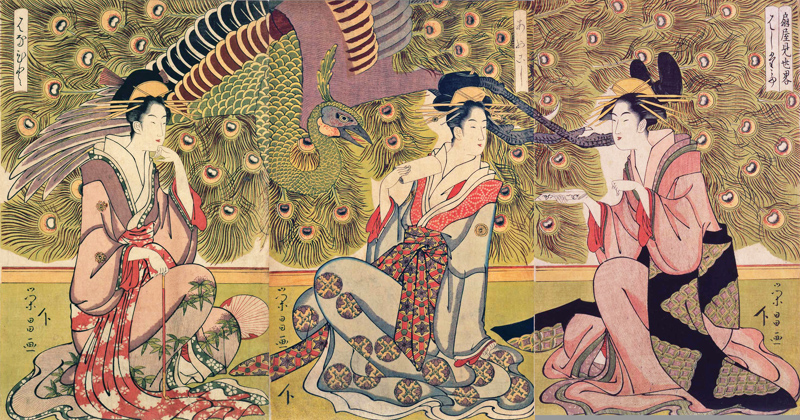
Chōkōsai Eishō “Interior of the Ōgi-ya House : Courtesans Hashidate, Ayakoshi, and Hanahito” (1st tern)

Utagawa Kunisada “Courtesan Yoyoyama of the Matsuba-ya House with Her Attendants, Kakeo and Nishiki” (2nd term)

Utagawa Kunisada “Collection of Beautiful Women : High-ranking Courtesan” (1st tern)
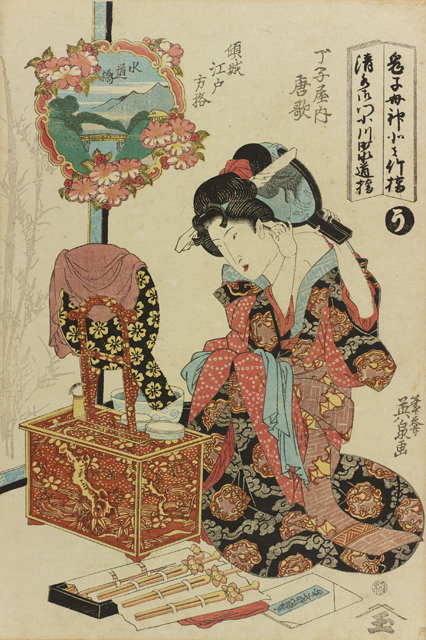
Keisai Eisen “Coutesans and Famous Places in Edo : Suidōbashi, Karauta of the Chōji-ya House” (1st tern)
Life in the brothels

Kitagawa Utamaro “Courtesan Reading a Letter” (2nd term)
Some ukiyo-e depicted the human sides of Oiran’s lives such as: reading a letter eagerly, taking care of their customers, being jealous, or relaxing with their colleagues. In this section, we will introduce how Oiran spent their time in the brothels, both in working hours and off-duty hours.
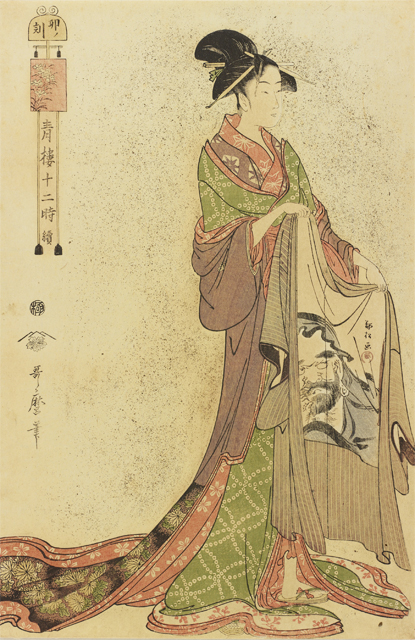
Kitagawa Utamaro “One Day in the Yoshiwara : Hours of the Hare (around 6:00)” (1st tern)

Kitagawa Utamaro “Seven Beauties in the Yoshiwara : Courtesan Tagasode of the Daimonji-ya House”
(2nd term)
The world of hand paintings

Miyagawa Chōshun “Standing Beauty” (1st tern)
The original paintings of “bijin-ga” (pictures of beautiful women) formed a popular genre that had been produced since the early period of ukiyo-e. Among those “bijin-ga,” the pictures depicting courtesans were especially gorgeous and carefully painted; and sometimes they were collected by prosperous people such as Daimyō (feudal lords). In this exhibition we will present the high-quality original paintings from the collection of the Ota Memorial Museum of Art. We hope you enjoy the elaborate and fashionable “bijin-ga” that show you a different world from wood block prints.

Chōbunsai Eishi “One Day in the Yoshiwara” (2nd term)
Highlight of the exhibition
Utagawa Toyoharu “Courtesan and Her Attendants Parading under Cherry Blossoms” (1st tern)

The procession of Oiran is held under a cherry blossom tree. The Oiran in the center wears a black overgarment with pine needle patterns, and the contrast between it and the red kimono with cherry blossom patterns creates a luxurious effect. The girls on either side of the Oiran are Kamuro (Oiran’s attendants). There are two women behind the Oiran: the one on the right is a Furisode shinzō (trainee courtesan), and the other on the left is probably a Bantō Shinzō (retired courtesan) who took care of the Oiran and taught how to attract customers. All women wear kimono with the same or similar patterns as the Oiran, making this picture very flamboyant. An Oirandōchū (a procession of Oiran accompanied by her attendants that marched through streets to meet up with customers) was allowed only for the highest-ranking Oiran.
Admission
| Adult | 700 yen |
|---|---|
| University and High school students | 500 yen |
| Junior High School Students and below | Free |
Calendar
Closed
-
-
-
2018 November
SUN MON TUE WED THU FRI SAT 1 2 3 4 5 6 7 8 9 10 11 12 13 14 15 16 17 18 19 20 21 22 23 24 25 26 27 28 29 30 -
2018 December
SUN MON TUE WED THU FRI SAT 1 2 3 4 5 6 7 8 9 10 11 12 13 14 15 16 17 18 19 20 21 22 23 24 25 26 27 28 29 30 31
-
-
Utagawa Hiroshige
[2nd Term] September 29th-October 28th


Utagawa Hiroshige”Wild Geese and the Moon” (1st tern)
Utagawa Hiroshige (1797~1858) was an ukiyo-e artist who lyrically depicted landscapes around Japan. His representative works such as “Fifty-three Stations of the Tōkaidō Road” and “One Hundred Famous Views of Edo” are not only famous in Japan but also around the world. This year, it is the 160th year since the death of Hiroshige. In commemoration, Ota Memorial Museum of Art is hosting a special exhibition introducing the entirety of Hiroshige’s art works.
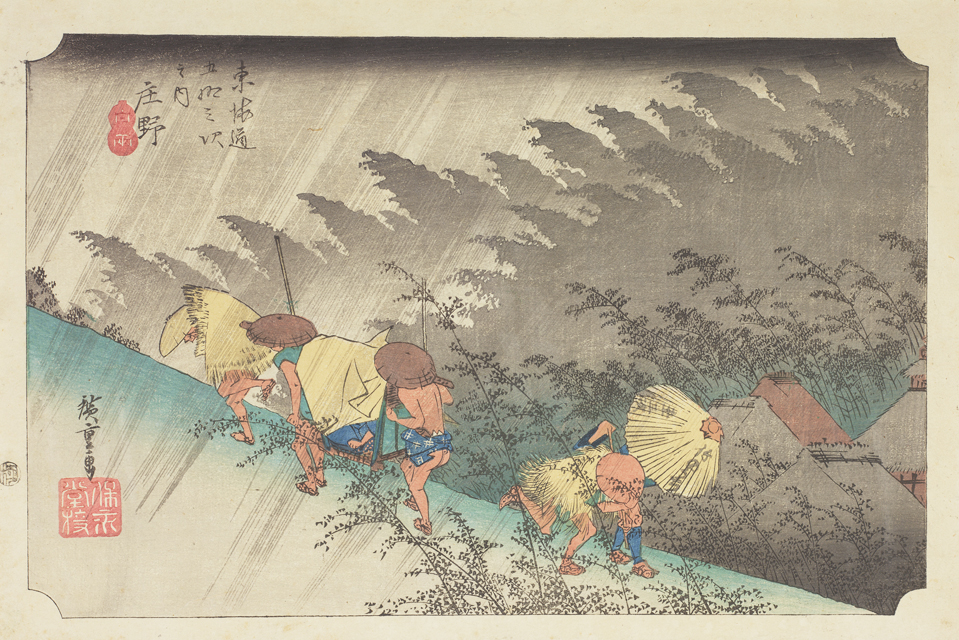
Utagawa Hiroshige “Fifty-three Stations of the Tōkaidō Road : Sudden Shower at Shōno” (2nd term)
160th anniversary of Hiroshige’s death.
Hiroshige died on the 6th September, 1858. We will host an exhibition commemorating the 160th anniversary of his death, during the month of his passing. In fact, works by Hiroshige constitute the largest portion in the museum collections. We will introduce a series of selected works, including his representative works “Fifty-three Stations of the Tōkaidō Road” and “One Hundred Famous Views of Edo”. This retrospective exhibition is being held for the first time in the past 13 years.

Utagawa Hiroshige “Fifty-three Stations of the Tōkaidō Road : Night Snow at Kanbara” (1st term)

Utagawa Hiroshige “Sixty-nine Stations of the Kisokaidō Road : Seba” (2nd term)
All about Hiroshige from masterpieces to rare works
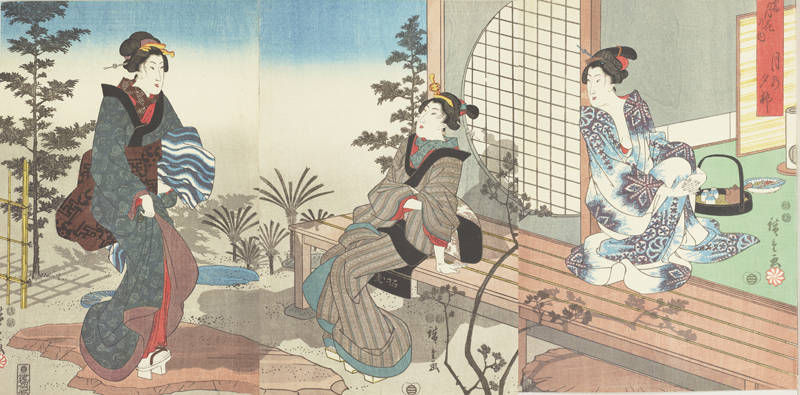
Utagawa Hiroshige “Snow, Moon and Flowers : Full Moon Night” (1st term)
It goes without saying that the most famous works of Hiroshige are that of landscapes. However, he drew various genre of pictures, such as “pictures of beautiful women” (bijin-ga), “pictures of flowers and birds” (kacho-ga) and “farcical pictures” (giga), which are rarely presented in ordinary exhibitions. We will exhibit more than 200 pieces of works, including these genres, throughout the first and second exhibition (all pieces in display will be changed between the two exhibitions). Your perception of Hiroshige may change after experiencing this exhibition.
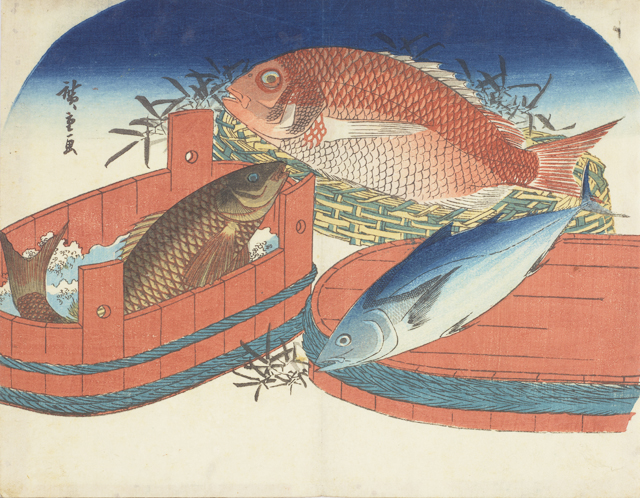
Utagawa Hiroshige “Sea Bream, Carp and Bonito” (2nd term)

Utagawa Hiroshige “Famous Places in Edo : Full Moon at Takanawa ” (1st term)
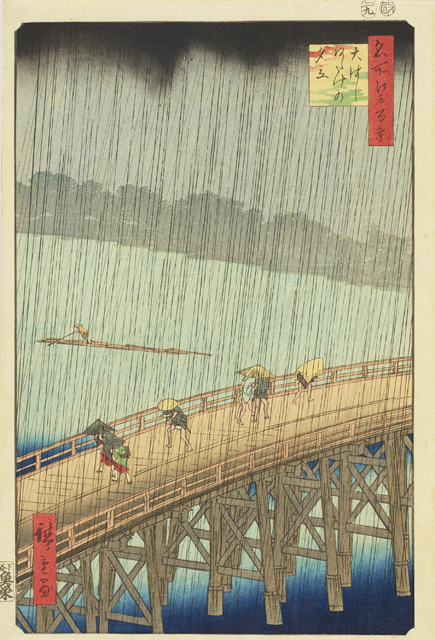
Utagawa Hiroshige “One Hundred Famous Views of Edo : Sudden Shower Over Shin-Ōhashi Bridge and Atake” (1st term)
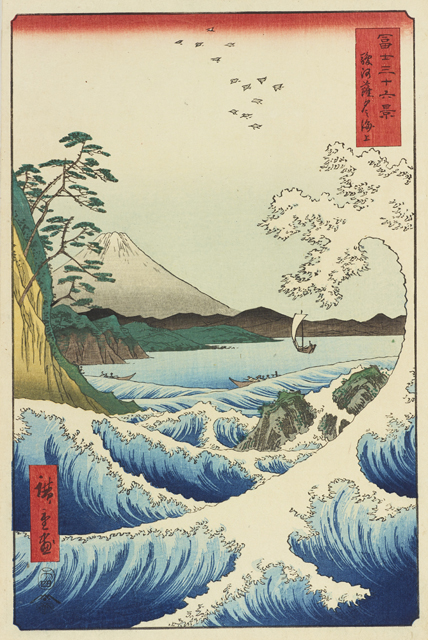
Utagawa Hiroshige “Thirty-six Views of Mt. Fuji : Sea off Satta in Suruga Province ” (2nd term)
Highlight of the exhibition – Hiroshige Blue
Utagawa Hiroshige “Fifty-three Stations of the Tōkaidō Road : Dusk at Numazu” (1st term)

This is the only picture depicting a moonlit night among the famous series “Fifty-Three Stations of the Tōkaidō Road.” It is dusk. Three travelers are walking in silence under the moonlight. Two nuns are walking in front of them. The man behind who has a big Tengu (long‐nosed goblin) mask on his back, is possibly going to visit the Konpira Temple. The travelers will arrive at Numazu station after crossing the bridge. Bero-ai (Berlin blue) imported from overseas is used as the color of the sky and the river, creating a beautiful world of blue called “Hiroshige blue”. This masterpiece is fitting for autumn, the season in which we enjoy the full moon with tranquility.
Admission
| Adult | 1000 yen |
|---|---|
| University and High school students | 700 yen |
| Junior High School Students and below | Free |
Calendar
Closed
-
-
-
2018 September
SUN MON TUE WED THU FRI SAT 1 2 3 4 5 6 7 8 9 10 11 12 13 14 15 16 17 18 19 20 21 22 23 24 25 26 27 28 29 30 -
2018 October
SUN MON TUE WED THU FRI SAT 1 2 3 4 5 6 7 8 9 10 11 12 13 14 15 16 17 18 19 20 21 22 23 24 25 26 27 28 29 30 31
-
-
Ochiai Yoshiiku

Ochiai Yoshiiku (1833~1904) was an ukiyo-e artist from the end of the Edo Period to the Meiji Period. He has created works which are essential to the history of ukiyo-e, such as“Twenty-eight Famous Murders with Verse”, a series of chimidoro-e (bloody paintings) which Yoshiiku and Tsukioka Yoshitoshi collaborated together, and “Shimbun (newspaper) Nishiki-e” that illustrated Meiji news articles with ukiyo-e. However, he had not attracted the public attention because of the other well-known ukiyo-e artists, namely Tsukioka Yoshitoshi, Kobayashi Kiyochika and Kawanabe Kyōsai. This will be the world’s first exhibition that sheds light to the entirety of the works of Yoshiiku, introducing more than 80 pieces of pictures including his most representative works.
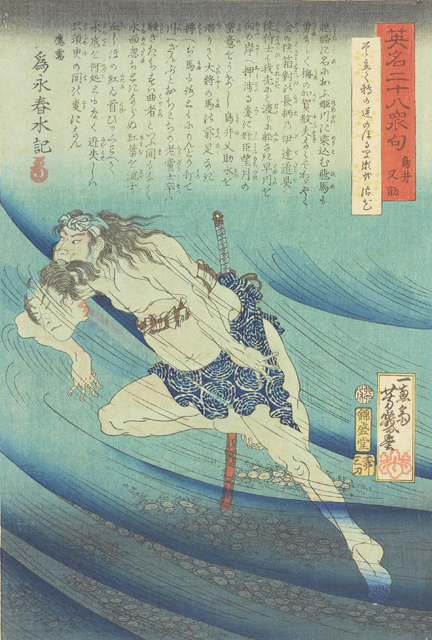
“Twenty-eight Famous Murders with Verse : Torii Matasuke”
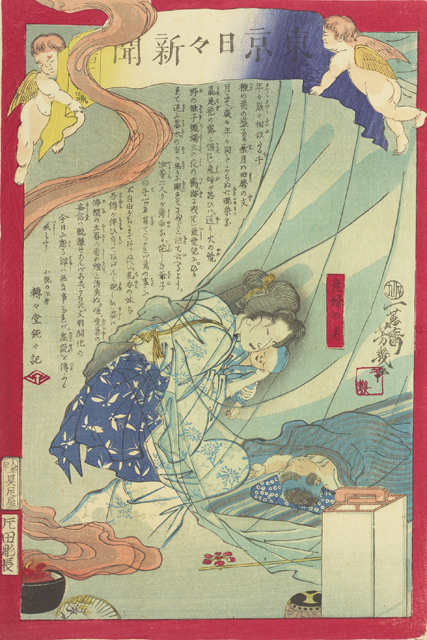
“Illustration Based on the Newspaper “Tokyo Nichi Nichi Shimbun” : No. 101”
The world’s first exhibition presenting the entirety of the works of Yoshiiku
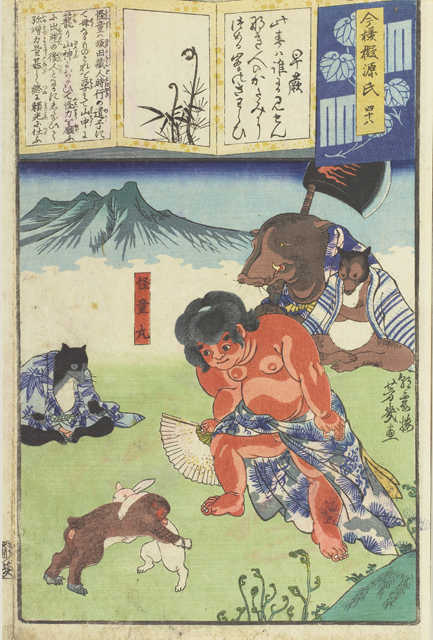
“Parody of the Tale of Genji : 48 Sawarabi, Kaidōmaru”
As a pupil of Utagawa Kuniyoshi, Ochiai Yoshiiku printed various genres of ukiyo-e at the end of the Edo Period, including “giga (caricatures)”, “pictures of beautiful women”, “warrior pictures”, “portraits of kabuki actors” and “Yokohama-e (foreigners and scenes of Yokohama)”. In the Meiji Period, he was active in areas beyond the genre of ukiyo-e, by taking part in the launch of a kabuki magazine and a newspaper called Tokyo Nichi Nichi Shimbun (now Mainichi Shimbun). In the past, Ota Memorial Museum of Art had introduced ukiyo-e artists who had not been in the limelight, such as Utagawa Yoshitsuya, Utagawa Hirokage and Mizuno Toshikata. In this exhibition, we are presenting the artistic world of Ochiai Yoshiiku.
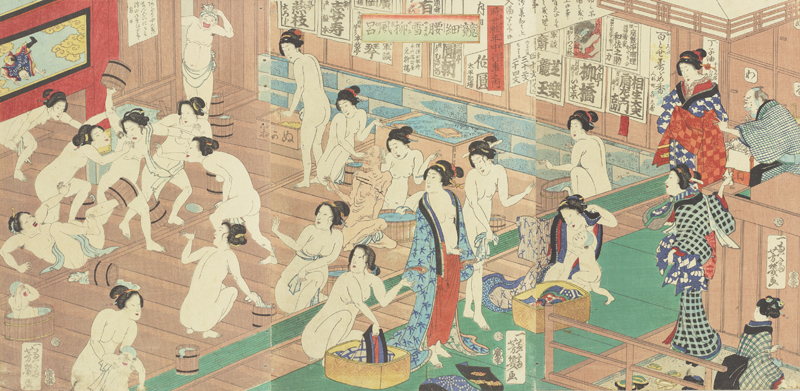
“Contemoporary Annual Events : Public Bath”
Masterpieces of chimidoro-e (bloody paintings) –As Yoshitoshi’s rival
When considering representative works of Yoshiiku, it is essential to acknowledge“Twenty-eight Famous Murders with Verse” , a series of pictures which Yoshiiku and his junior disciple Tsukioka Yoshitoshi collaborated in creation. As indicated in the title chimidoro-e (bloody paintings), they skillfully depict the brutal scenes of murder in kabuki plays and kōdan (storytelling). Yoshiiku and Yoshitoshi each printed 14 pieces to complete the series. In this exhibition, we not only introduce all 14 pieces created by Yoshiiku, but also various chimidoro-e.
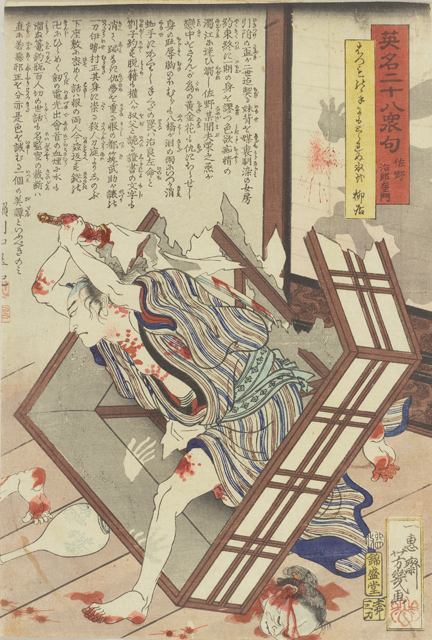
“Twenty-eight Famous Murders with Verse : Sano Jirōzaemon”

“Illustration Based on the Newspaper “Tokyo Nichi Nichi Shimbun” : No. 833”
Unique creativity inherited from Kuniyoshi
Utagawa Kuniyoshi, the master of Yoshiiku, drew animals as humans and actively learned from painting techniques of foreign countries. Yoshiiku inherited such styles of his master and created many pictures with unique ideas, such as parody pictures depicting fish as portraits of kabuki actors, pictures drawn in silhouette, and photo-like pictures. Please enjoy the humorous styles of expressions by Yoshiiku.

“Goldfish Resembling Kabuki Actors”

“True Silhouette of Kabuki Actors : Seki Sanjūrō Ⅲ”

“Mirror of Photographs of Kabuki Actors : Onoe Kikugorō Ⅴ as Nikki Danjō”
Exhibition of Tsukioka Yoshitoshi held in Nerima Art Museum simultaneously
Nerima Art Museum is hosting an exhibition “Yoshitoshi, a genius ukiyo-e artist who lived during the turbulent period” from August 5th (Sun) to September 24th (Mon). They will exhibit all the pictures from “Twenty-Eight Famous Murders with Verse” which Yoshiiku and Yoshitoshi vied in creation. It will be the best opportunity to compare the works of two rival artists, Yoshitoshi and Yoshiiku.
“Yoshitoshi, a genius ukiyo-e artist who lived during the turbulent period”
2018, August 5th-September 24th
Nerima Art Museum(1-36-16 Nukui, Nerima-ku, Tokyo)
https://www.neribun.or.jp/museum.html
Highlight of the exhibition
“Twenty-eight Famous Murders with Verse : Shundō Jirōemon”
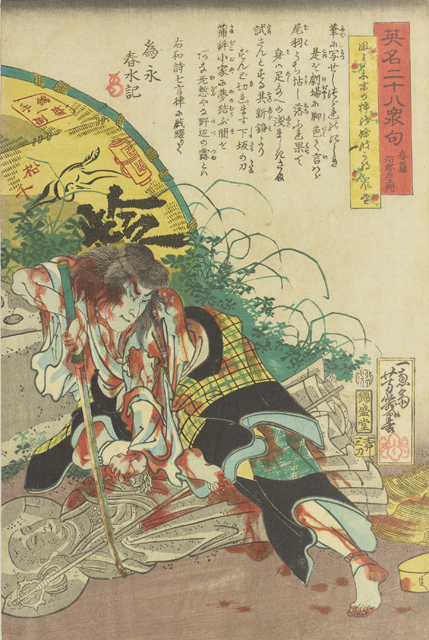
“Twenty-eight Famous Murders with Verse” is a series of pictures which Yoshiiku and Yoshitoshi collaborated in creation. It is a representative work of chimidoro-e (bloody picture), depicting brutal scenes in kabuki plays and kōdan (storytelling). This picture shows Shundō Jirōzaemon who disguised himself as a poor man to achieve his revenge. He has miraculously survived through the deceptive attack by the ones who suspected his true identity. Although he is covered with blood and has a pale face, the intensity of his gaze shows us the strength of his volition to accomplish his revenge.
Admission
| Adult | 700 yen |
|---|---|
| University and High school students | 500 yen |
| Junior High School Students and below | Free |
Calendar
Closed
-
2017 August
SUN MON TUE WED THU FRI SAT 1 2 3 4 5 6 7 8 9 10 11 12 13 14 15 16 17 18 19 20 21 22 23 24 25 26 27 28 29 30 31
Villains in Ukiyo-e PARTⅡ
[2nd Term] June 30th-July 29th
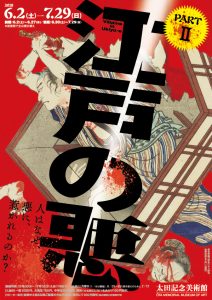

名所江戸百景 隅田川水神の森真崎(前期展示)
Why are we attracted by “evil”?
In TV dramas, movies and novels, villainous roles are often depicted as more attractive than the protagonist roles. The people of Edo also seem to have been aware of the unfathomable attraction of “evil”. For example, when a notorious thief was caught and dragged around the streets, it was filled with people who came to catch a glimpse of the legendary evil man. Big incidents such as Akō Incident in the Genroku period were made into kabuki plays immediately, and Kira Kōzukenosuke, considered to be the villain of the incident, established his position as an evil figure. At the end of the Edo Period, a genre of plays called “Shiranami mono” in which many thieves appeared was popular, and the thieves and scoundrels in these plays were adored. Whether it was in reality or in fiction, people in those days were curious about the charm of “evil”, and were sometimes intoxicated by it.
This exhibition is a revival of one of our most popular exhibitions, “Villains in Ukiyo-e” held in 2015, this time featuring more ukiyo-e that depicts various “villains”. Thieves such as Nezumikozō Jirokichi, chivalrous men such as Banzuiin Chōbei, malicious authorities, evil women and wicked sorcerers, and other villainous figures in Edo from both reality and fiction, are brought to you again in Ota Memorial Museum of Art.
I From thieves, chivalrous men, masterless samurai to villainous authorities, evil women and wicked sorcerers – “villains” in Edo reunited.
Great thieves such as Ishikawa Goemon, chivalrous men such as Karigane Gonin Otoko, Ro-nin (masterless samurai) such as Ono Sadakurō, depraved priests such as Hokkaibō, malicious authorities such as Fujiwara-no Tokihira, evil women such as Dote-no Oroku, and wicked sorcerers such as Nikki danjō. In the Edo period, outlaws and villains grew popular, and were adapted to plays and stories with various dramatization. From those who existed in reality, to those who were created in fiction, “villains” in Edo is brought to you again in Ota Memorial Museum of Art.
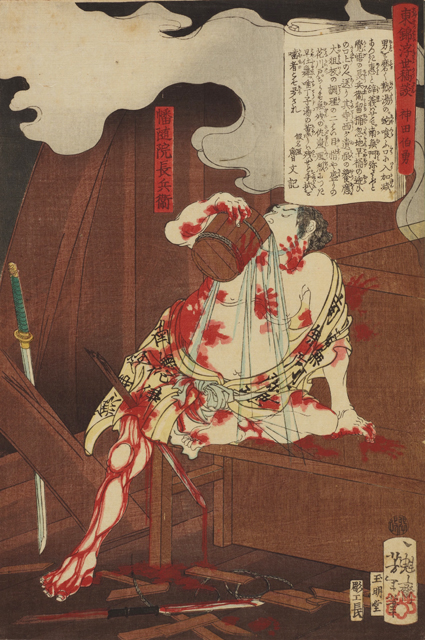
Tsukioka Yoshitoshi : Rough Tales of the Floating World Told on Eastern Brocades : Banzuiin Chōbei Murdered in the Bathroom (2nd term)

Utagawa Kuniyoshi : Kabuki Play “Kinoshita Soga Megumi no Masagoji” (2nd term)

Tsukioka Yoshitoshi : Eimei Nijūhasshūku (Twenty-eight Famous Murders with Verse) : Ingakozō Rokunosuke (1st term)

Tsukioka Yoshitoshi : New Selection of Eastern Brocade Pictures : Chōan Killing His Younger Brother at Fudanotsuji (1st term)
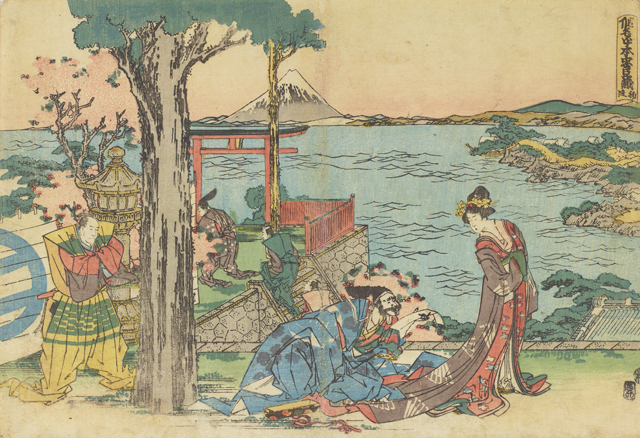
Katsushika Hokusai : Kabuki Play “Kanadehon Chūshingura : Act 1” (1st term)
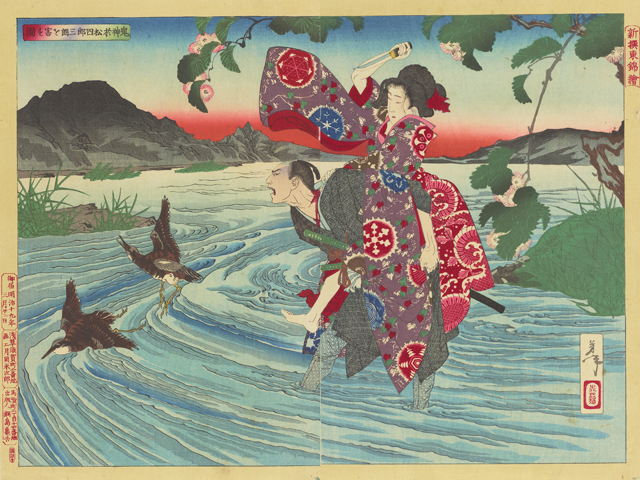
Tsukioka Yoshitoshi : Shinsen Azuma Nishiki-e (New Selection of Eastern Brocade Pictures): Kijin Omatsu Killing Shirosaburō (2nd term)

Toyohara Kunichika : Sōma Yoshikado and Takiyasha-hime at an Old Temple (2nd term)
Ⅱ Love and evil
Soapy-opera love affairs were a preferred subject among kabuki plays. “Tōkaidō Yotsuya kaidan”, a famous ghost story by Tsuruya Nanboku Ⅳ, focuses on Tamiya Iemon and his wife Oiwa, and the evil caused by the distorted love of man and woman. The play is based on a true story about Yaoya Oshichi, who commited arson to meet her lover Kichisaburō. The play soon became popular, and many kabuki plays were created and performed. Interestingly, a depraved priest Seigen, in the play “Seigen and Princess Sakura”, who was obsessed with Princess Sakura even after his death, can be considered the first stalker in Japan.
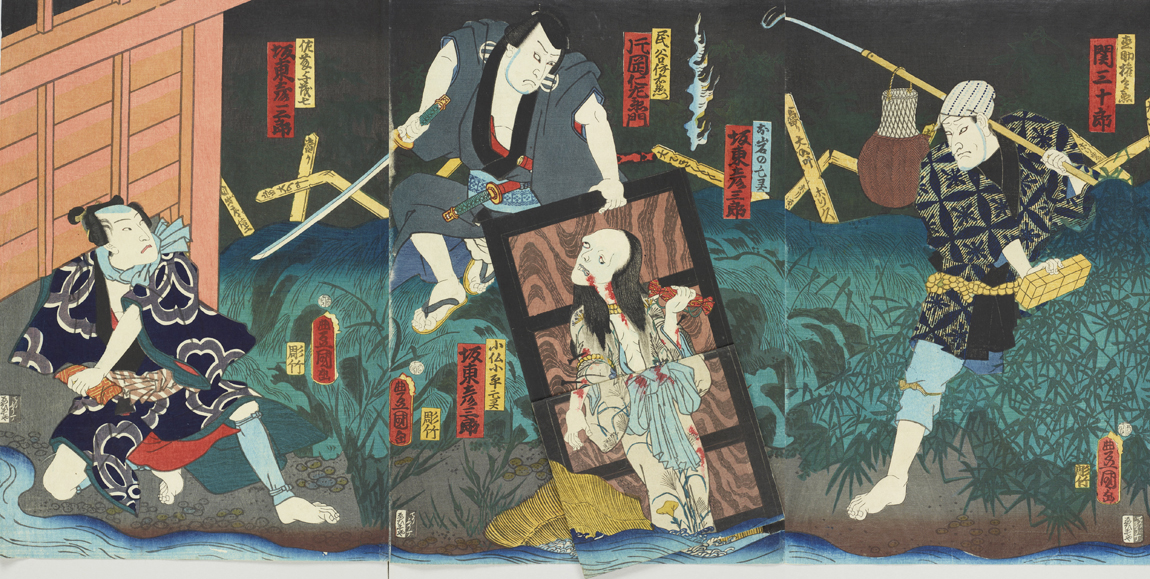
Utagawa Kunisada (Toyokuni Ⅲ) : Kabuki Play “Tōkaidō Yotsuya Kaidan” (2nd term)
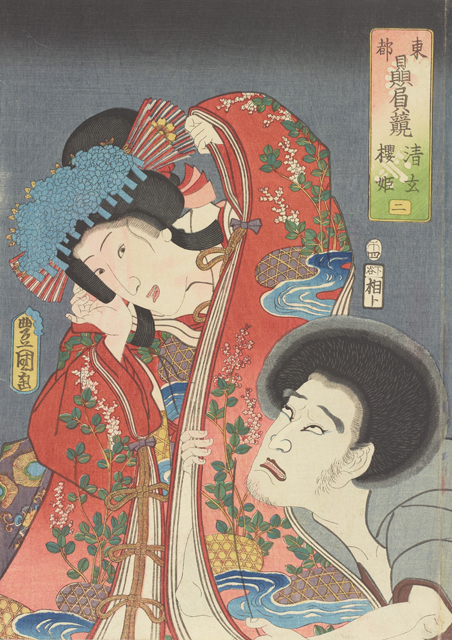
Utagawa Kunisada (Toyokuni Ⅲ) : Tōto Hiiki Kurabe : Seigen and Sakura-hime (1st term)
Ⅲ Between good and evil
The boundary between “good” and “evil” is quite ambiguous. In kabuki plays and Japanese narrative chants, there are stories in which a good person like Sanojirō Zaemon cannot stand the terrible insults he receives and kills many people. On the other hand, there are other stories about a villain like Igamino Gonta in the kabuki play “Yoshitsune Senbon Zakura (Yoshitsune and the Thousand Cherry Trees)”, who performs a good deed before he dies. This attractive subject of people moving between good and evil must have grabbed the interest of people back then.

Ochiai Yoshiiku : Eimei Nijūhasshūku (Twenty-eight Famous Murders with Verse) : Sano Jirōzaemon (1st term)
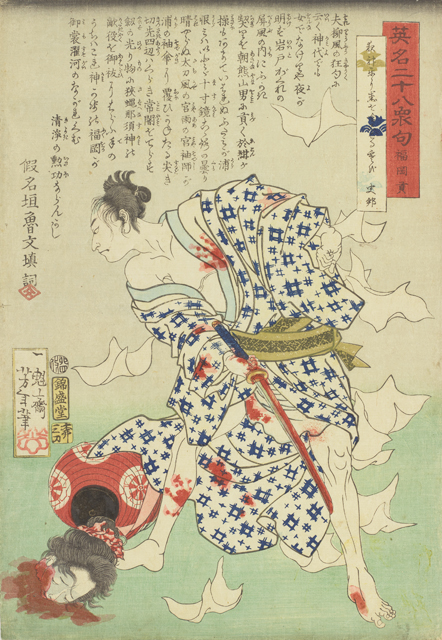
Tsukioka Yoshitoshi : Eimei Nijūhasshūku (Twenty-eight Famous Murders with Verse) : Fukuoka Mitsugi (2nd term)
Admission
| Adult | 1000 yen |
|---|---|
| University and High school students | 700 yen |
| Junior High School Students and below | Free |
Calendar
Closed
-
2018 June
SUN MON TUE WED THU FRI SAT 1 2 3 4 5 6 7 8 9 10 11 12 13 14 15 16 17 18 19 20 21 22 23 24 25 26 27 28 29 30
-
2018 July
SUN MON TUE WED THU FRI SAT 1 2 3 4 5 6 7 8 9 10 11 12 13 14 15 16 17 18 19 20 21 22 23 24 25 26 27 28 29 30 31
Hiroshige “One Hundred Famous Views of Edo”
[2nd Term] May 1st-27th


One Hundred Famous Views of Edo : Suijin Shrine and Massaki on the Sumida River (1st term)
The 160th anniversary of Hiroshige’s death –Excellent works of Hiroshige
2018 marks the 160th year since the death of Utagawa Hiroshige (1797~1858), a great master of “landscape pictures”. In commemoration, Ota Memorial Museum of Art is holding the exhibitions “Hiroshige ‘One Hundred Famous Views of Edo’” in April and May, and “Utagawa Hiroshige” in September and October. In fact, the number of Hiroshige’s works is the largest among our museum collections, with more than 2,600 pieces. This year we will thoroughly showcase the wonderful works of Hiroshige, by introducing selected pieces from our collection.
Immortal works during Hiroshige’s later years

One Hundred Famous Views of Edo : Kinryūzan Temple, Asakusa (2nd term)
For the first exhibition, we will introduce the series “One Hundred Famous Views of Edo”, which includes widely famous works, such as “Kinryūzan Temple, Asakusa”, “Plum Park in Kameido” and “Sudden Shower Over Shin- Ōhashi Bridge and Atake”. This series, on which he spent the last three years of his life, is representative of Hiroshige’s later works. This grand series consists of 120 pieces of work, including an index picture and 2 works drawn by his pupils. We will exhibit the entirety of it by separating them. The works in Ota Memorial Museum of Art is considered to be well preserved, and is one of the earlier prints, thus reflecting Hiroshige’s intents. Please enjoy the artistic world Hiroshige has reached in his later years through these excellent works.
Beautiful memories of Edo
The Sumida River with full-bloomed cherry blossoms, Kameido Tenjin Shrine with wisterias, Saruwaka-machi under the moon and Sensōji Temple in snow… About 160 years ago, Hiroshige vibrantly portrayed the city of Edo with his established technique. However, only 10 years after his death and the publishing of the series “One Hundred Famous Views of Edo”, the Edo period ended and the Meiji period started. The series captures the scenery of Edo before its drastic and rapid change after the Meiji period. Some remain the same, while some are already lost. This series is like a time capsule, which allows us to experience the atmosphere near the end of the Edo period.

One Hundred Famous Views of Edo : Inside Kameido Tenjin Shrine (2nd term)

One Hundred Famous Views of Edo : Night View of Saruwaka-machi (1st term)

One Hundred Famous Views of Edo : Asakusa Ricefields and Torinomachi Festival (1st term)
Bold compositions
Hiroshige preferred to draw scenery on a vertical screen in his later years. “One Hundred Famous Views of Edo”, includes many unique works using this style and drawing the subject largely in the front, through extreme perspective. This bold composition even creates the feeling that we are actually in the Edo city, which gives “One Hundred Famous Views of Edo” charm like no other. We cannot help but be amazed by his passion for production paintings with new compositions, even when he was over 60 years old.

One Hundred Famous Views of Edo : Mannenbashi Bridge, Fukagawa (2nd term)

One Hundred Famous Views of Edo : Fukagawa Susaki Jūmantsubo (1st term)
Masterly techniques
While ukiyo-e prints have various kinds of carving and printing techniques, “One Hundred Famous Views of Edo” displays the most difficult and time-consuming techniques. Some examples are, the technique of expressing rain through thin and sharp lines on printing blocks, using color graduation to express the sky or the water surface, and creating embossed surfaces by rubbing the print hard without any paints called “Karazuri”. The masterly techniques of the carvers and painters supporting Hiroshige’s works are also enthralling.
Highlight of the exhibition Hiroshige, the one loved by Van Gogh
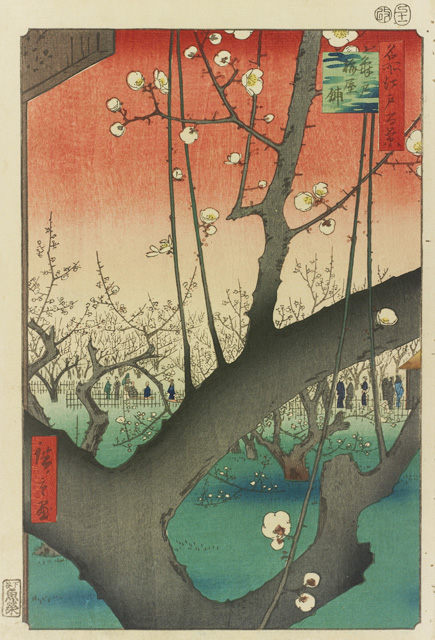
One Hundred Famous Views of Edo : Plum Park in Kameido (1st term)

One Hundred Famous Views of Edo : Sudden Shower Over Shin-Ōhashi Bridge and Atake (2nd term)
“Plum Park in Kameido” gives a unique impression, with its bright color and bold composition depicting the plum tree larger than the screen. “Sudden Shower Over Shin- Ōhashi Bridge and Atake” captures the moment when the people are caught in a sudden shower and running hastily across the bridge. Both works are popular masterpieces from “One Hundred Famous Views of Edo”.
Recently, the influence of ukiyo-e on the post-impressionist painter Vincent Van Gogh has come under the spotlight again. Of all works of Hiroshige, these two were copied as oil paintings and are known as the works that Van Gogh showed great interest. The bold composition and the use of vibrant color, achieved by established technique, must have had an impact on the artists in the Western countries. These works, which fascinate people in all parts of the world not only represent ukiyo-e but also Japanese arts.
Admission
| Adult | 700 yen |
|---|---|
| University and High school students | 500 yen |
| Junior High School Students and below | Free |
Calendar
Closed
-
2018 April
SUN MON TUE WED THU FRI SAT 1 2 3 4 5 6 7 8 9 10 11 12 13 14 15 16 17 18 19 20 21 22 23 24 25 26 27 28 29 30
-
2018 May
SUN MON TUE WED THU FRI SAT 1 2 3 4 5 6 7 8 9 10 11 12 13 14 15 16 17 18 19 20 21 22 23 24 25 26 27 28 29 30 31
